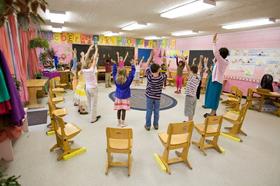Admissions to Private School: A-Z puts all the information you need to navigate the private school admissions process in one convenient place. Whether you are just beginning or have been through this before, you will find the help and advice to guide you through the various steps involved in submitting an application for admission to private school.
The Admissions Process
Our Application Calendar will keep you organized throughout the stressful process of applying to private school. There's a lot to keep track of. So plan your work carefully and try to stick to the schedule. Ideally, you have started the process at least 18 months before the expected date of starting school. For example, for fall 2017 admissions, you need to begin in the spring of 2016. If you are an international student, you need to allow an additional six months because there are some important additional steps which you need to follow. Here is an introduction to the Lower School at Rye Country Day School.
Applying to any private school is just that, an application. Why is that? Private schools do not have to accept your child. That is one of the essential differences between public and private schools. Remember that that places in schools in major metropolitan areas tend to be very limited. Enhance your prospects by avoiding common admissions mistakes. What if they waitlist your child? Is that the end of the world? Not exactly. What happens when you start the process late for some valid reason such as a job relocation and miss the deadlines? Does it matter? Is there any leeway? It depends.
The most important thing to understand about the admissions process is that it allows you and the school to size each other up. Your child's admissions profile tells a story about her and her accomplishments. The school visit gives you a chance to scope out the school and see what it is really like. What both you and the school are looking for is a good fit. You want the assurance that the school will meet your needs, requirements and expectations. The school wants to reassure itself that your child and you will fit into the school community, as well as to confirm through testing that she can do the academic work.
Testing
At the high school level, most private schools require all applicants to take a standardized admissions test. The SSAT and ISEE are the most commonly used tests. Roman Catholic schools frequently use TACHS, COOP or HSPT for admissions testing. At the primary level, schools use a variety of standardized tests such as OLSAT or WPPSI. Some schools use tests which they have developed in house.
Private schools use standardized admissions tests to level the admissions playing field. The test scores enable the admissions staff to see how each applicant compares to the rest of the applicant pool. If your child has known issues with any core academic subject such as math or reading comprehension, you might want to think about hiring a tutor to give your child some extra help. Often all that your child needs is a different way of looking at a subject as well as some one-on-one attention to build her confidence. Don't leave this kind of remediation until the last minute.
All you have to do is register and drop your child off at the test site on the specified date, right? Not exactly. Your child must practice taking the test. Sign your child up for the online practice tests and buy the test preparation books available for the SSAT and ISEE and other commonly administered admissions tests. Then set aside a Saturday morning for her to work a test under simulated test conditions. Working a couple of practice tests will allow your child to be relaxed and confident on the day of the test. He will have been there and done that. He will be at his best.
If your child is an international student, remember that you will need to have him prepare for TOEFL as well. He may be extremely fluent in English, however, if he is not a United States citizen or permanent resident and English is not his first language, he will have to take the Test of English as a Foreign Language. The schools to which you are applying need to know that your child understands English well enough to be successful. Almost all the academic work will be taught in English. As with the admissions test, have your child work online exercises and tests until he scores well before taking the actual test.
The Visit and the Interview
You must visit each of the schools on your short list. School visits are not optional. Yes, the video tours and Skype visits with the admissions people are wonderful and an efficient way of finding out more about the school, however, you need to see the school as it actually is. Shadow for a day. Sit in on a class. Spend an overnight if possible.
If you do indeed live overseas and cannot travel to the United States, you may be able to meet with admissions staff who travel abroad in the fall on recruiting tours. Contact the individual schools to see if they participate in recruiting tours and find out when someone will be in your area.
While being interviewed, remember to play your cards carefully. The school is looking you over but, more importantly, you are looking it over. Keep your cool. Ask intelligent questions. Avoid making comments such as "Well, your school is our third choice." Keep your options wide open.
Applications
Applying to private schools is so much easier because schools have put most of the process online. It still is a detailed, multi-step process with a lot of forms to fill out. You need to do this before the school's deadlines. Don't assume that because School A has a deadline of January 31 that School B will have the same deadline. Several schools use a common application form which makes applying even easier. Unfortunately, several schools still require you to download and print out forms. You complete the application and mail it to the school. Consultant Sandy Eiges gives us some application tips in the following video.
Complete personal documentation such as the Parent's Statement yourself. Don't have an assistant do it. The school wants to understand what your thoughts are in your own words. Same thing applies to your child's statement which also known as Candidate's Statement. Let your child write it unaided. Resist the temptation to review what she says. The admissions staff are savvy enough to know whether your child has had help writing her statement.
Teacher Recommendations and Transcripts are a critical part of any application. Again, don't leave these to the last minute. Wherever possible, complete these tasks by November 1. When you leave things until later in November, you run into a very busy time of the year with the Thanksgiving holiday in November and end of semester activities in December.
I invite you to follow me on Twitter. @privateschl












